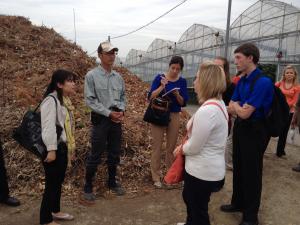By: Courtney Leeper, University of Missouri
The 2014 International Collegiate Agricultural Leadership (I-CAL) team members got an up-close look at food production and processing in Japan during the second and final week of the program. A joint initiative between the National FFA Organization and the U.S. Grains Council, I-CAL 2014 was made possible through support from The Grains Foundation. Established in 1983 by members of the Council, part of the Foundation’s mission is to nurture the next generation of leaders in the agricultural and agribusiness sectors.
Throughout the week, the team visited a flour port and milling facility; a bread manufacturing facility; a food soybean processing facility; and grape, dairy, tomato, mushroom and rice farms.
Japan imports about 60 percent of its food. This is essential to a modern diet, because large tracts of land suitable for farming are scarce in Japan. As a result, Japanese farms are generally small and focused on value-added products. With very little domestic production of feed grains, the livestock sector depends on imports from countries like the United States.
The largest farm we visited was a 17-acre dairy farm that included dairy processing facilities and a restaurant. Tadao Yuge, the owner, feeds his 50 cows a mix of grains like corn and barley along with imported hay.
The team also visited a flour mill in Kobe as well as a food soybean processing facility. We learned that the majority of the wheat and soybeans these facilities used were sourced from the United States. In fact, the flour mill sourced about 60 percent of its wheat from the United States, which equates to about 3 million metric tons (110 million bushels).
On May 30, we returned to our homes all across the United States with an eagerness to share our experiences and insights with our communities. Several team members already have plans to share with their communities, Farm Bureaus, Cattlemen’s Associations, student organizations and more.
We discovered the importance of international trade during this mission. The relatively small island nation of Japan, with its mountainous terrain, is nevertheless able to meet its demand for high-quality food with help from the United States. When trade works, the world wins.



